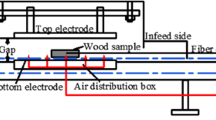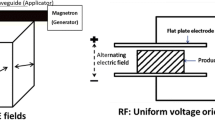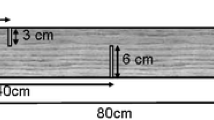Abstract
The research was aimed to establish whether dielectric heating at radio frequencies (RF)—an alternative method to ozone-depleting methyl bromide fumigation and to convective heating—could bring green lodgepole pine boards infested with pinewood nematodes (PWN) to pasteurization requirements. Artificially infected specimens were treated using a laboratory RF oven and post-treatment nematode survival levels were assessed. Both tested combinations of 56°C/30 min and 60°C/15 min were effective in eradicating PWN. A power density of 50 kW/m3 maintained for 75 minutes fully pasteurized all the tested boards and proved to be the right combination if no temperature sensors are used. The data gathered supports the idea that pasteurization by RF heating is a reliable and swift alternative treatment to fumigation and convective heat treatment.
Zusammenfassung
In dieser Studie wurde untersucht, ob mit Hochfrequenzerhitzung (HF), einem alternativen Verfahren zur ozonschädlichen Methylbromid-Begasung und zu konvektiver Hitzebehandlung, die Anforderungen an die Pasteurisierung von mit Kiefernholznematoden (PWN) befallenem frischem Kiefernschnittholz erfüllt werden können. Künstlich infizierte Proben wurden unter Verwendung einer Hochfrequenzeinrichtung behandelt und anschließend wurde die Überlebensrate der Nematoden bestimmt. Sowohl eine Behandlung bei 56 °C/30 min als auch bei 60 °C/15 min erwies sich als zur Abtötung von PWN effektiv. Bei einer Energiedichte von 50 kW/m3 über eine Dauer von 75 Minuten wurden alle Proben vollständig pasteurisiert. Dies erwies sich als richtige Kombination falls keine Temperatursensoren benutzt werden. Die erfassten Daten bestätigen die Annahme, dass Pasteurisierung durch Hochfrequenzerhitzung eine zuverlässige und rasche Behandlungsalternative zur Begasung und traditionellen Hitzebehandlung darstellt.




Similar content being viewed by others
References
Avramidis S, Liu F, Neilson BJ (1994) Radio-frequency/vacuum drying of softwoods: drying of thick western redcedar with constant electrode voltage. For Prod J 44(1):41–47
Baker AC (1939) The basis for treatment of products where fruit flies are involved as a condition for entry into the United States. US Department of Agriculture Circular No 551
Bergdahl DR (1988) Impact of pinewood nematode in North America: present and future. J Nematol 20:260–265
Dwinell LD (1997) The pine wood nematode: regulation and mitigation. Annu Rev Phytopathol 35:153–166
Food and Agriculture Organization (FAO) of the United Nations (2002) Guidelines for regulating wood packaging material in international trade. Inter Standards for Phytosanitary Measures No 13 (ISPM 15). FAO of the United Nations, Rome, 14 p
Hoover K, Uzunovic A, Gething B, Dale A, Leung K, Ostiguy N, Janowiak JJ (2010) Lethal temperature for pinewood nematode, Bursaphelenchus xylophilus, in infested wood using microwave energy. J Nematol (submitted for publication)
Lazarescu C, Plattner A, Hart F, Breuil C, Avramidis S (2009) Pasteurization of Hemlock by radio frequency heating: a preliminary study. For Prod J 59(4):79–83
Mamiya Y (1983) Pathology of the pine wilt disease caused by Bursaphelenchus xylophilus. Annu Rev Phytopathol 21:201–220
Mota MM, Braasch H, Bravo MA, Penas AC, Burgermeister W, Metge K, Sousa E (1999) First report of Bursaphelenchus xylophilus in Portugal and in Europe. Nematology 1:727–734
Nelson SO (1978) Frequency and moisture dependence of the dielectric properties of high-moisture corn. J Microw Power 13(2):213–218
Takasu F (2009) Individual-based modeling of the spread of pine wilt disease: vector beetle dispersal and the Allee effect. Popul Ecol 51(3):399–409
Torovnikov GI (1993) Dielectric properties of wood and wood-based materials. Springer, Berlin, 196 p
Tzean SS, Tang JS (1985) The occurrence of the pine wood nematode, Bursaphelenchus xylophilus, in Taiwan. In: Proc ROC symp electron microsc, 6th, pp 38–39
Wingfield MJ, Blanchette RA, Nicholls TH, Robbins K (1982) The pine wood nematode: a comparison of the situation in the United States and Japan. Can J For Res 12(1):71–75
Yang B, Qouli W (1989) Distribution of the pinewood nematode in China and susceptibility of some Chinese and exotic pines to the nematode. Can J For Res 19:1527–1530
Yi C, Park J, Chang K (1989) Occurrence of pine wood nematode, Bursaphelenchus xylophilus (Steiner et. Buhrer) Nickle, and its vector, Monochamus alternatus Hope, in Korea. In: Proc IUFRO reg workshop for insect pests and tree dis NE Asia. For Prod Res Inst, Tsukuba, Jpn, pp 183–193
Acknowledgements
This work is financially supported by a Strategic Grant from the Natural Sciences and Engineering Research Council of Canada. As part of the work was done through support of staff at FPInovations we also wish to thank Canadian Forest Service that financially supported this work under the Contribution Agreement existing between the Government of Canada and FPInnovations, Division Forintek. The input regarding the experimental design and technical information about the RF-heating by Dr. Terry Enegren is greatly appreciated
Author information
Authors and Affiliations
Corresponding author
Rights and permissions
About this article
Cite this article
Lazarescu, C., Dale, A., Uzunovic, A. et al. Radio frequency heating pasteurization of pine wood nematode (Bursaphelenchus xylophilus) infected wood. Eur. J. Wood Prod. 69, 573–578 (2011). https://doi.org/10.1007/s00107-010-0515-x
Received:
Published:
Issue Date:
DOI: https://doi.org/10.1007/s00107-010-0515-x




